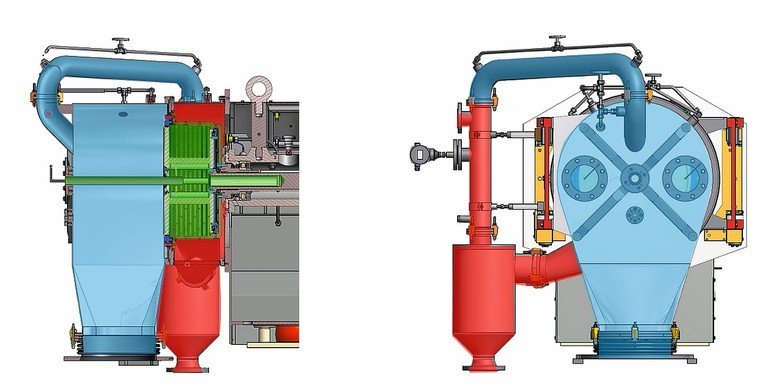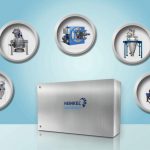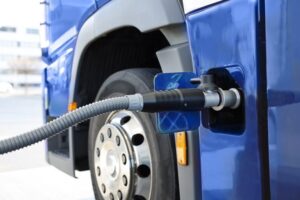Explosion risks in chemical and pharmaceutical production plants arise due to a number of factors in work processes such as filtering, screening, agitating and separating: the type of substance or medium, for example solvents or flammable hazardous substances, as well as handling and processing. The safety characteristics of these substances are key for the risk assessment. To achieve a high safety level in areas exposed to explosion hazards, plant operators are obliged to implement the specifications of the relevant laws, directives, rules and standards. This includes ensuring a proper operational condition at all times as well as frequent maintenance of safety systems by qualified personnel.
Improved safety in zone 0
Centripurge is a TÜV-tested SIL 3 inerting concept which makes it easier for operators to adhere to the applicable safety regulations and fulfil the requirements of TRGS 725. The design is based on the highest requirement level, where an explosive atmosphere and a source of ignition are assumed to be continuously present in a non-inerted process area (Zone 0). This results in a SIL 3 monitoring device with a hardware failure tolerance of 2 (HFT2). In other words, Centripurge guarantees safe operation of equipment in explosion-proof areas in accordance with current statutory requirements. Operators do not need to have any validation measures of their own in place. This standardisation saves time and money. Centripurge has a modular structure and can be adapted to suit individual needs, for instance in Zone 1 or 2, where reduced safety requirements apply in the process area. In this case, both the SIL requirement and the hardware failure tolerance are lower. Heinkel also has the experience and know-how to support its customers with inerting updates for third-party equipment. Existing installations or obsolete systems can be retrofitted and modernised using Centripurge. Furthermore, the manufacturer provides expert assistance regarding the legally stipulated annual audit of the inerting facilities, so that continuous compliance with all relevant standards and guidelines is ensured.
Flow-through inerting
The purpose of inerting systems or parts of systems is to displace the atmospheric oxygen content within the equipment by adding inert gases to the extent that the formation of an explosive atmosphere is avoided. These inerting measures have to be monitored reliably. The use of suitable measuring and control devices as part of the explosion prevention measures reduces the probability of an explosive atmosphere forming and hence also the risks due to explosive mixtures and ignition sources. The reliability of these devices is regulated by TRGS 725, which was most recently tough-ened up in 2016. With several decades of experience and process know-how from numerous customer projects, Heinkel has succeeded in realising an inerting concept for centrifuges which complies with these strict standards and guidelines and offers operators a high degree of flexibility when it comes to installation-specific requirements. The Centripurge inerting concept for centrifuges is based on the principle of flow-through inerting and has been awarded a positive SIL 3 test certificate for its optimal risk reduction in areas exposed to explosion hazards. Whereas the inverting filter centrifuge has a continuous inert gas flow to avoid condensation, inert gas is only supplied in other types of centrifuge if the pressure falls below a set value, in order to ensure a minimum pressure in the process area. Plant operators profit from a level of safety that is virtually unprecedented in inerting systems. The safety integrity level, or SIL for short, is used to quantify risk reduction in connection with functional safety. It is a safety assessment criterion which provides information on the reliability of the safety functions in automation engineering. The risk associated with each individual safety function is assessed with reference to the relevant standards. The SIL is determined by analysing the failure behaviour of the components concerned and checking them for redundancies, continuity and errors. When the TÜV-tested inerting concept was developed, the leak tightness of the process area and the connecting pipework was tested during a first diagnostic phase. The system was charged with inert gas for this purpose. Both the supply of inert gas and the achievement of the test pressure are monitored redundantly. The second step entailed pre-inerting, that is the expulsion of oxygen in all areas of the centrifuge. This is time controlled; the flow of inert gas is monitored redundantly. The final phase of inerting served to ensure a continuous supply of inert gas to compensate for leakage flows. As in the diagnostic phase, both the supply of inert gas and the minimum pressure are monitored continuously as well as redundantly. The protection concept is realised with a safety instrumented control system. Heinkel’s inerting concept – the hardware components, the TIA/S7 control software and the necessary documentation – was repeatedly optimised until finally the fulfilment of all relevant requirements in all areas was confirmed by the testing institute.
Online search: cpp0218heinkel
Hall 5.0, Booth B8









